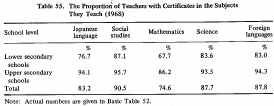| Home > Policy > White Paper, Notice, Announcement > White Paper > EDUCATIONAL STANDARDS IN JAPAN 1971 > CHAPTER |
||
It is obvious that there are some problems to be solved from the viewpoint of teacher's training for the future, e.g., the composition of teachers according to the institutes they graduated from, the balance of supply and demand of teacher's indifferent areas, and the balance of teachers according to the subjects they teach.
Among the newly recruited teachers in March, 1969 the percent of public school teachers who were graduates of national teacher's training colleges or faculties was 53% in elementary schools, 44% in lower secondary schools and 18%in upper secondary schools. In this figure the newly recruited include teachers, assistant teachers and instructors who are graduates of previous years. The total number of graduates of national teacher's training colleges has hardly changed over the years, and graduates of ordinary universities are required to fulfil the balance of supply and demand.' This means that when the demand for teacher's increases, the percent that are graduates of national teacher's training colleges decreases.
The number of persons who graduated from universities or junior colleges and acquired teacher's certificate is 123,000. Among them 30,000 were actually employed as teachers. Looking at the figures by type of schools, the number of those who acquired certificates is 25 times that of those actually employed in the case of lower secondary schools, and 12 times that of those actually employed in upper secondary schools, while it is only 1.4 times as high in the case of elementary schools. This indicates that in some regions the pressure of supply and demand is high. In the case of the teachers of lower secondary schools fifty-one percent of the 49,000 persons who acquired teachers certificates are graduates of junior colleges, but of them only 491 persons were actually recruited.
To aid in analyzing the regional differences in the balance of supply and demand of teachers, the figures for recruitment and for these leaving the profession in 1961 -68 is shown by prefectures in Basic Table 53. It indicates that the differences are rather large.
In five prefectures the percent of those recruited is higher than that of those who left the profession at all levels. In the three prefectures adjacent to Tokyo, which are overpopulated due to recent in-migration, the tendency is especially remarkable. Conversely there arc eleven prefectures where the percent of those who left the profession is higher than that of those recruited at all levels. In these prefectures a population out-migration is more or less visible. In order to meet this population mobility it is necessary to formulate a plan to balance the supply and demand of teachers over rather large regions.
Regarding the balance of supply and demand of teachers according to the subjects they teach, one notes a shortage of mathematics teachers. Both in lower secondary schools and upper secondary schools, as compared with other subjects, mathematics has the lowest percent of teachers with formal certificates for that subject.
In lower secondary schools, next to mathematics, Japanese language has the next lowest percent of teachers with formal certificates to teach that subject.
Generally speaking lower secondary schools have fewer than eleven classes. Since the number of teachers a school can employ is limited by its size, in these schools with fewer classes it is impossible to have teachers with formal certificates for every subject. These results in increases in the percent of teachers without formal certificates for some subjects they teach.

Note: Actual numbers are given in Basic Table 52. Basic Table 52
| Back to Top | MEXT HOME |